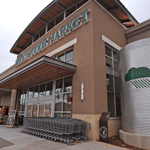With roughly 500,000 residents, Raleigh, North Carolina, is nothing if not urbane—and an urbane market demands sophisticated offerings. Enter the newest iteration of progressive, Austin-based grocer Whole Foods Market. “The ‘Triangle’ [Raleigh, Durham, and Chapel Hill, NC] for us is a strong customer base, and we wanted to go for the gold with our North Raleigh store,” says Mike Farish, executive construction coordinator with Whole Foods. By “gold,” Farish means LEED Gold. The 40,000-square-foot, single-story grocery store was completed in March 2011 and received the certification in April 2012; it is the first LEED Gold Whole Foods in the region and the fifth in the nation.
The idea of going for LEED Gold occurred to Farish and his team after the store’s developer decided to pursue Silver certification through LEED Core & Shell version 2.0. “Supermarkets and restaurants are the two highest energy consumers among commercial buildings, so we’re always trying to make our buildings as sustainable as possible,” Farish says. “We feel like our designs meet that criterion, but the only way to judge it is to get certification from a third party. It’s easy for us to say we’re sustainable—it’s another thing to prove it.”
11,000 gallons of water that can be held in the Raleigh store’s cistern. Water is used in the store bathrooms and gives the market some highly visible sustainability street-cred.
To get there, Farish says, “We really pushed ourselves on water conservation.” The building’s plumbing design incorporates an 11,000-gallon rainwater cistern—prominently displayed at the front of the store—that captures water that is then repurposed for flushing all of the building’s toilets and urinals. The cistern reduces potable water use by more than 80 percent, says Rene Ferandel, principal and director of architecture and engineering services at GreenbergFarrow Architecture, the architect of record for tenant improvements.
“Our primary design approach focused on integrating sustainable elements and practices throughout the site and the entire building,” says Ferandel. “Notably, we achieved exemplary performance by utilizing over 50 percent regional materials, including reclaimed barn wood for interior finishes; selecting over 90 percent Energy Star-rated equipment; and using advanced lighting controls to achieve a reduction in lighting power.” The store HVAC system uses 29 percent less energy than comparable baseline grocery stores, Farish adds, and its ambitious recycling projects divert 90 percent of the store’s waste from landfills.
Community involvement also is an important part of sustainability for Whole Foods. To engage customers, Farish, StudioGee Architecture, and GreenbergFarrow designed a large wall display to explain the store’s green features—things like ceramic tiles, refrigeration tubing, and energy-saving lights. They also installed a television in the market area that runs programming about Whole Foods’ sustainable efforts.
The store is great for the eco-conscious Raleigh market, where consumers tend to care where their food comes from. “They want their grocery store to back that up,” Farish says, “and they shop with us because they see we’ve made a commitment to sustainability.”

